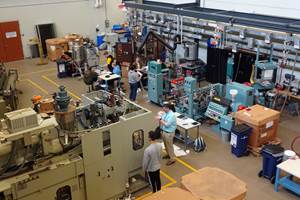Share
Read Next

Adam Narkter, MMT EAB member and Diversified Technologies International (DTI) business development manager. Source | DTI
Q: Diversified Technologies International (DTI) applies a disciplined and systematic approach to simulation iterations for mold processes and design from a plastics point of view. How do you define the scope and objectives of your simulation iterations? What are the key performance indicators (KPIs) and acceptance criteria that you use to evaluate the results?
A: A simulation is a tool that we believe is key to unlocking the potential pitfalls in the relationship between part designs, material selection, mold design, molding machine capabilities and process strategies. A mold flow analysis is run for every custom mold we build. The scope of each analysis strategy starts with a foundation of Cool + Fill + Pack + Warp with a preliminary runner system and cooling/waterlines. This has been a good starting point for most simulation needs and then we can change the scope based on specific application requirements.
For example, some parts we build custom molds for are limited in how they can be gated, while other parts have more options available for gating type and location. With the latter scenario, we will plan for more iterations and time to compare the results of Cool + Fill + Pack + Warp on multiple different gating options. The KPIs driving a successful simulation analysis include, but are not limited to, proper material characterization, target cycle time achieved, process parameters (tonnage, flow rate, injection pressure, etc.) that can be replicated in target production machine(s), whether warp is acceptable for part performance/assembly, etc.
Q: How do you select the appropriate simulation software and settings for your mold processes and design?
A: There are many good simulation software packages available, and we chose to use Moldflow by Autodesk. This is a highly regarded software that most OEMs and engineering teams have accepted to deliver reliable results. We also use the software that is best supported in the location of our tool builds and engineering staff. The settings of our simulation are driven by material characterization, target cycle time and decoupled molding techniques.
Q: How do you validate and verify your simulation results with physical experiments and measurements? What are the sources of uncertainty and error in your simulations and how do you reduce them?
A: When we get to the point of first shots/mold sample and subsequent process development, we set up the molding process to start as close as possible to the simulated process. This requires converting the machine-independent molding process from simulation to specific settings in the trial/production molding machine. We will then step through our scientific injection molding (SIM) process development package to ensure a stable and repeatable process. From here, we can measure parts and correlate part dimensions to these stable/repeatable process settings. If dimensions are out, we determine the steel grooming plan and, once groomed, sample the mold again with the same process settings. We will measure parts again to ensure successful dimensional results and quality approval.
The result of this approach is confidence in how to process the mold to achieve dimensionally capable, quality-approved parts. Some of the sources of uncertainty in simulation have to do with warp. The direction of the warp is usually very accurate, yet the actual real-world magnitude of the warp in the molded part is sometimes less or more than what was simulated. This is a result of normal material variation and the actual cooling rate the mold can achieve compared to the simulation.
Q: How do you communicate and document your simulation findings and recommendations to your stakeholders and customers?
A: We use our standard DTI-branded PowerPoint presentations and share the full analysis. We schedule collaborative meetings to review each aspect of the simulation. We use red, yellow and green color coding to identify areas and items of design for manufacture (DFM) that will need to be completed, changed, verified and confirmed before moving on to final design approval. This makes our DFM reports easy to follow and interpret concerns/roadblocks. All this is for the reduction of risk in producing quality parts at the quoted cycle time.
Q: How do you incorporate feedback and learning from your simulation iterations into your mold processes and design improvement?
A: Evaluating simulation results and making decisions on the number of gates, location and size can be, and typically is, implemented in real-time design improvements. However, we also keep all DFM reports and design reviews saved and documented for future reference when building similar products. We apply lessons learned from our long history of tool builds to make similar products launch more efficiently.
Q: What are the methods and tools that you use to optimize your mold design parameters, such as gate location, runner size, cooling system, etc?
A: The tools we use are a combination of Moldflow simulation software and Unigraphics mold design software. We have also created DTI-branded DFM templates for part and mold designs. Finally, we include our SIM process development workbook completed for each mold and automated process transfer worksheets that quickly enable the master process to be transferred to other capable machines.
The use of these tools and our process described above does not capture the full list of variables to consider and possible KPIs for a successful mold build and launch. However, it highlights some of the complexity associated with launching new product and tooling. Therefore, we must follow this disciplined and systematic process. In the end, our customers are confident in the quality and performance of their new mold.
Related Content
How to Balance Roles, Integrate New Talent and Embrace Industry 4.0
What follows is a Q&A with Isaac Trevino, an MMT EAB member and Best Tool and Engineering (BTE) Business Development Manager.
Read MoreNavigating the Future of Mold Design and Manufacturing
What follows is a Q&A with Justin Jagels, an MMT EAB member and owner/president of J Squared Design Services LLC.
Read MoreThe Intersection of Robotics, Hands-on Training in Mold Design Curriculum
A Q&A with Nicholas Vitelli, MoldMaking Technology EAB member and engineering lecturer at Penn State Erie, The Behrend College.
Read MoreEditorial Advisory Board 2023-2026: Meet New Board Member Gabe English, Western Carolina Tool & Mold
The 2023-2026 version of MoldMaking Technology's EAB features a new crew of industry professionals. Meet Gabe English
Read MoreRead Next
Editorial Advisory Board 2023-2026: Meet New Board Member Adam Nartker, Diversified Technologies International
The 2023-2026 version of MoldMaking Technology’s EAB features a new crew of industry professionals. Meet Adam Nartker.
Read MoreAre You a Moldmaker Considering 3D Printing? Consider the 3D Printing Workshop at NPE2024
Presentations will cover 3D printing for mold tooling, material innovation, product development, bridge production and full-scale, high-volume additive manufacturing.
Read MoreReasons to Use Fiber Lasers for Mold Cleaning
Fiber lasers offer a simplicity, speed, control and portability, minimizing mold cleaning risks.
Read More























